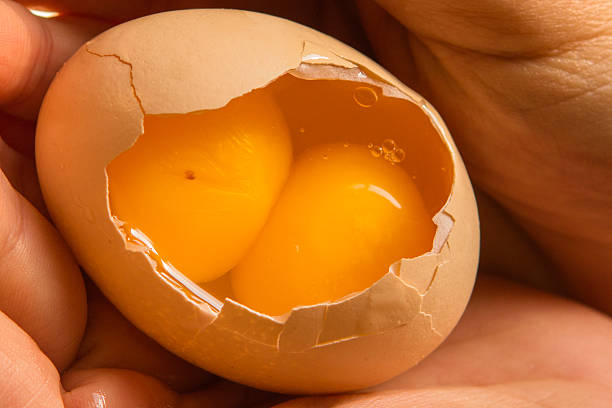

As chicks start to grow up and lay eggs, you may find a double yolk egg in your egg collecting basket. To be clear, double yolk eggs are just that. When you crack a single-shelled egg open, you won’t find a fully formed egg inside an egg, instead, you’ll find two yolks inside.
It’s funny because so many of us live our lives buying eggs from the grocery store. The eggs are uniformly sized, perfectly colored and have no oddities. But, this is a distorted reality and not the way chickens really lay eggs. (Commercially, odd eggs are used in food where they can’t be seen such as baking and cake mixes.) In reality, there can be lots of odd eggs laid by a hen over the course of her lifetime. Most of them are edible and perfectly fine to eat. Think about it, hens can lay a thousand or more eggs in their productive years. The mathematical odds of something being perfect every time are low, if not impossible.
So what causes a double yolk egg? To understand that, it’s necessary to review how a hen lays an egg. Hens are born with all the eggs they will ever be able to lay already inside them. (This is the same with female humans too.) The yolks are contained in the chicken’s left ovary, which is her only working ovary. Once the hen is of laying age, individual yolks will mature and be released into the oviduct. It takes a hen 26 hours or so to form and lay an egg. Then about an hour after laying, another mature yolk will be released and start going through the egg formation process.
Double yolk eggs or in rare cases, triple yolk eggs, are formed when the hen releases two or more yolks at once. They move through the reproductive tract and are encased by a single shell.
You may wonder how you know if your hen laid a double yolk egg. Most times those eggs will be much bigger than a standard size egg; double and even triple the size. This isn’t always the case, though, some hens lay double yolk eggs that looked exactly the same size as a standard egg. But that’s rare.
Double yolk eggs are more likely to happen as chickens begin their laying cycle. At that point, a hen’s body is starting to get into a rhythm, and as with any rhythm, it can be hard to pick up the beat every time. Double yolk eggs can also happen at the end of hen’s laying cycle as things are winding down causing that rhythm to be thrown off beat.
Double yolk eggs are not lash eggs, which are a sick chicken symptom and not really an egg at all. You may find that double yolk eggs can mimic chickens laying soft eggs. In reality, the same amount of calcium goes into a double yolk egg shell as goes into a standard size shell. So, you may find your double yolk egg shells a little softer than normal.
Soft eggs are not always a sign of sickness, although a hen regularly laying soft shelled eggs should be monitored as this can be a sign of infectious bronchitis and oviduct issues such as salpingitis. But, most likely a soft egg is caused because of warm weather or because your hen needs more calcium in her diet. For warm weather, just make sure your hens have adequate places to get out of the direct sunlight such as under trees, shrubs or decks and have plenty of accessible fresh water. For inadequate calcium, it’s a good idea to feed your chicken’s egg shells back to them. You can clean them and then crush them up into small pieces and offer them free choice in a bowl or treat container. You should always make sure to feed a well-balanced layer feed to your flock and you can add supplements such as herbs from your garden.
Statistically speaking, double yolk eggs happen in about one in every thousand eggs. They are more common in hybrid and large breed chickens and can be hereditary. (In some countries, hens that lay double yolk eggs are prized and bred to lay them.) Although they are not a sign of illness, double yolk eggs can cause problems for the laying hen. Consistent laying of extra large eggs can lead to egg binding, where the chicken cannot pass the egg and it’s stuck inside or prolapse where part of the oviduct is sticking out of the chicken’s vent on the outside of her body.
Ultimately, a double yolk egg or other odd eggs, happen during the productive years of a laying hen and they’re nothing to worry about. We shouldn’t expect a hen to lay a perfect egg every time she lays. But, if you get a lot of odd eggs consistently from one hen or from many flock members then it may be a clue that something is wrong.
 Contact Jaguza Support
Contact Jaguza Support